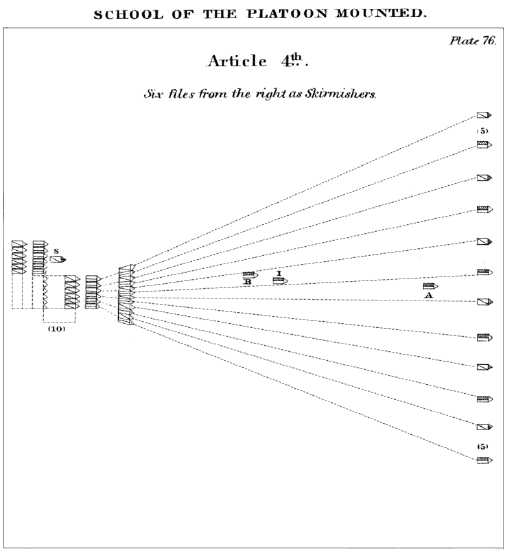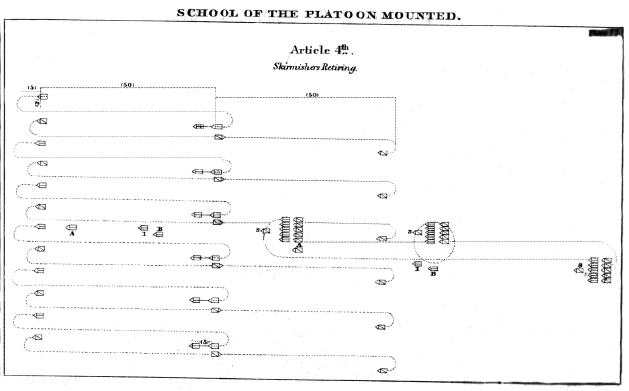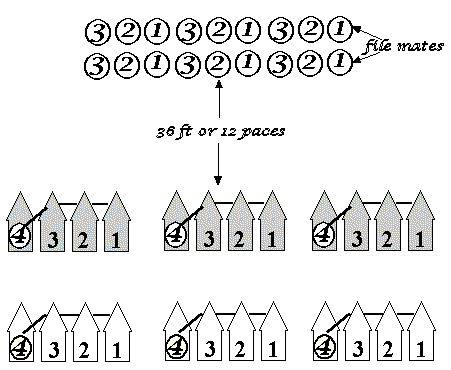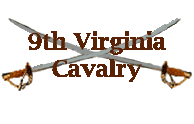- Skirmishing.
-
-
572.
The platoon
being supposed to form a part of the squadron, it is dispersed as skirmishers,
in order to cover the front and flanks of the squadron.
The platoon being in line at the extremity of the ground, the instructor
causes the shabraques to be raised, the holsters to be uncovered, and the arms
loaded; he marches the platoon forward, and when he wishes to disperse the
troopers as skirmishers, he commands:
- 1. Six
files from right - as skirmishers.
- 2. MARCH.
- 3. Guide
right.
(Plate 76.) At the first command, the file-closer places himself in front of
the six files of the left, of whom he takes command.
These six files are destined to support the skirmishers and to relieve them.
At the command MARCH, the file-closer commands HALT to the six files of
the left, and causes them to draw the sabre.
At the same command, the six files of the right continue to march forward;
after going 10 paces, they disperse as skirmishers, extending themselves so as
to cover the supposed front of a squadron, in passing beyond each of its
flanks. The right trooper obliques to the right, the left trooper to the left.
The troopers of the rear rank come up as soon as possible, abreast of the
front rank, each one placing himself on the left of his file leader, and as
soon as they are in line all take the position of advance CARBINE,
or raisePISTOL. They continue to march until the signal halt,
NO. 2.
The instructor causes the halt to be sounded when the skirmishers are
at 100 or 150 paces from the reserve.
The troopers keep at 5 paces apart, regulating themselves toward the guide
during the whole time they act as skirmishers.
The assistant instructor places himself in rear of the skirmishers, in order
to superintend their movements.
573The chief of the
platoon, followed by his trumpeter, places himself half-way between the
skirmishers and the reserve; he moves along the line wherever he thinks his
presence most necessary. The reserve and the skirmishers execute their
movements at the signals of the trumpeter who follows the officer.
If the chief of the platoon wishes the skirmishers to move forward he causes forward,
No. 1, to be sounded; each skirmisher moves forward, regulating his
movements by those of the guide and preserving his interval; the reserve
follows them, keeping at its proper distance.
To move the skirmishers towards the right, to the right, No. 4,
is sounded; each trooper turns to the right, and marches in the direction of
those who precede him, taking care to preserve his distance; the reserve also
turns to the right.
To face the skirmishers again to the front, to the left, No. 3,
is sounded; the skirmishers and the reserve turn to the left.
To move the skirmishers toward the left, to the left, No. 3, is
sounded; each skirmisher turns to the left and marches in the direction of
those who precede him, taking care to preserve his distance. The reserve also
turns to the left.
To face the skirmishers again to the front, to the right, No. 4,
is sounded; the skirmishers and the reserve turn to the right.
If, after having turned to the right, the instructor wishes the skirmishers to
move toward the opposite side, he orders, the about, No. 5, to
be sounded: the skirmishers and the reserve turn to the left-about, and move
forward.
If, after having turned to the left, the instructor wishes the skirmishers to
move toward the opposite side, he orders, the about, No. 5, to
be sounded: the skirmishers and the reserve turn to the right-about, and move
forward.
During the flank movements, if the troopers are to continue firing, they leave
the column and face to the enemy for that purpose. As soon as they have fired,
they resume their places in the column in doubling the gait.
(Plate 77.) The skirmishers are marching to the front or at a halt; if the
instructor wishes the line to move to the rear, the chief of platoon orders
the retreat to be sounded. At this signal, the troopers of the front rank move
forward 5 paces, fire, then turn to the left-about in order to move to the
rear, and retire loading their pieces. When they have marched 50 paces, or
more if necessary, the chief of platoon causes the about, No. 5,
to be sounded. At this signal, the troopers, who were retiring, face to the
front by turning to the right-about. The troopers who are in the first line
fire and turn to the left-about, retire in loading their pieces, pass in the
intervals of the line which is in rear, move 50 paces further, and face to the
front at the signal, the about, No 5.
The troopers of the line which is in rear move 5 paces to the front the moment
the troopers who retire pass into their intervals; they then commence firing
by the flank indicated.
The alternate movement of the two lines continues as long as skirmishers move
to the rear. When the instructor wishes the retreat to cease, the chief of
platoon orders forward, No. 1, to be sounded. The skirmishers
who are in rear move up, in doubling the gait, abreast of those the most
advanced, and all march forward until the signal, to halt, No. 2,
is sounded.
If the instructor wishes the whole line of skirmishers to retire at once, he
orders the about, No. 5, to be sounded.
The reserve retires and faces to the front, regulating its movement by that of
the skirmishers, so as to remain always at 60 paces from the 2d line. It
executes its rear movement at the moment the retreating line passes into the
intervals of the line which moves forward.
574.The rallying of
skirmishers is always made on the point occupied by the officer.
To rally the skirmishers, the officer places himself habitually in front of
the reserve, and causes the rally, No. 6, to be sounded. At this
signal the skirmishers turn-about, rally on the reserve by the shortest route,
and draw the sabre.
If the officer is not with the reserve when the rally, No. 6, is
sounded, the skirmishers rally upon him, and the reserve comes up and joins
them. The troopers are thus exercised to rally upon any point whatever the
line.
575.If a defile is
presented in advance of the front of the line, and orders are given to pass
it, the troopers who are opposite first enter it; they are followed at some
distance by the other troopers, who turn by trooper to the left, and to the
right, in order to put themselves in file.
As soon as the first have passed the defile, they move 50 or 60 paces to the
front; the others come up abreast of them in obliquing, those of the right to
the right, and those of the left to the left. The reserve enters the defile
when the first skirmishers have reconnoitred it.
If the skirmishers are to pass a defile placed in rear, they commence by
approaching it; when the reserve is at a suitable distance it passes rapidly,
and posts itself 50 or 60 paces from, and on the side of the passage.
The two troopers who are on the flank, turn-about to the left, move to the
rear so as to arrive together at the entrance to the defile, which they pass
immediately. They are followed closely by the other troopers, who execute
successively the same movement; the centre troopers, who execute successively
the same movement. The centre troopers, who cover the defile, enter it last.
At the going out of the defile, the two troopers who are in front turn, one to
the left and the other to the right; and when all troopers have passed the
defile, they stop at the signal to halt, No. 2, and face to the
front.
The instructor sometimes rallies the skirmishers immediately after having
passed the defile, either to the front or to the rear.
576.These
movements are first executed at the walk, then at the trot, and finally at the
gallop. When the troopers have learned to perform those movements well, they
are exercised at them in executing the manual of arms, and in firing; and
finally, with the overcoats rolled and carried over the shoulder. When the
troopers are at the gallop, and the instructor wishes them to pass to the
trot, he orders the trot, No. 7, to be sounded; when they are at
the trot and he wishes them to pass to the walk, he orders, the halt, No.
2, and then forward, No 1, to be sounded.
577.To commence or
cease firing, the signal is sounded. All troopers do not fire at once, but one
after another, commencing on the side of the guide. They afterwards continue
firing without waiting for, or being governed by each other. Each rear-rank
man has an understanding with his file-leader that, as far as practicable, the
piece of one may always be charged while the other is loading; the troopers of
the same file should give mutual support to each other.
When the platoon skirmishes without gaining ground to the front, the
skirmishers should nevertheless keep in motion always; each trooper of the
front rank, after having fired, moves some steps to the rear, at the same time
loading his piece; and as soon as he returns to the line, the rear-rank man of
the same file fires, and moves in his turn to the rear.
In the charge as foragers, the men of the rear rank approach within 1 or 2
paces of their file leaders, to be able to support each other mutually.
As soon as the skirmishers charge, the reserve moves forward to support them.
The skirmishers retire by turning-about to the left, and face again to the
front by turning-about to the right. When they have reformed in platoon, they
return the pistol to the holster, or drop the carbine, and draw sabre.
(Lancers carry the lance.)
578.To relieve
skirmishers, the instructor commands to the reserve:
1. Six
files from left - as skirmishers.
2. MARCH.
3. Guide
right.
At the command MARCH, the reserve disperses and moves up upon the line
of old skirmishers. The right trooper of the front rank passes on the right of
the right skirmisher of the front rank; the right trooper of the rear rank on
the right of the right skirmisher of the rear rank, and so on throughout, each
one passing to the right of the one he relieves, and 5 paces beyond him. The
old skirmishers turn-about and rally at the gallop on the officer, who, during
the movement, is placed at the point where the six files, now become the
reserve, should reform.
The non-commissioned officer who commanded the six files of the left, now
takes command of the six files of the right.
If there are two non-commissioned officers with the platoon, each one follows,
the portion of the platoon to which he is attached.
DRAGOONS. - The dragoons having been sufficiently exercised in all the
movements of skirmishing, will be taught to dismount and form with celerity to
fight on foot.
At the commencement, all the movements of this instruction with be decomposed,
in order to make them better understood.
The platoon being in line, the instructor commands:
Prepare to fight -
ON FOOT.
1 time, 4 motions
1. At the last part of the command, which is ON FOOT, prepare to
dismount as prescribed, No. 292.
2. Execute what is prescribed, to dismount, No. 292; Nos. 4, of each rank,
will remain mounted.
3. Return to the ranks as prescribed, No. 292, face to the right, pass the
reins with the right hand over the head of the horse, seize the extremity of
the reins with the left hand, seize them again with the right hand, 6 inches
from the mouth of the horse, the nails upward; face to the front and hook up
the sabre without letting go the reins.
4. Face-about to the right, seizing the reins with the left hand, 6 inches
from the mouth of the horse, the nails downward; slip the right hand to the
extremity of the rein; Nos. 3 of each rank give the reins to Nos. 4, who
remain mounted; Nos. 2 and 1 engage the end of the reins with both hands in
the head-stall of the bridle of the horse which is on the left, passing them
under the noose-band and the cheek-piece of the bridle, and tying them in a
slip-knot, so that each horse may be about one foot from the one to which he
is tied; face again to the front by the right, unsling the carbine, and come
to a carry.
The instructor commands:
Dragoons -
INTO LINE.
1 time
At the last part of the
command, which is INTO LINE, move 12 paces to the front, turning the
back upon the platoon of horses; half the rear rank pass to the right by the
right flank, the other half to the left by the left flank, and place
themselves behind their file-leaders.
Nos. 4, who remain on horseback, have charge of the dismounted horses; they
take the end of the reins of the first dismounted horse in the left hand,
holding them near the bit with the right hand, the nails downward; an
assistant instructor, or file-closer of the platoon, remains with the
dismounted horses to direct them.
The dragoons having been sufficiently exercised at the different movements of
this instruction, will be required to execute them rapidly without stopping at
the several motions, and at the single command, prepare to fight on foot,
given by the instructor.
The two ranks being formed, the platoon will be conducted where it is to fight
on foot, and will be there exercised in what has been prescribed, Nos. 211,
215, 239.
The dismounted horses will also be exercised in changing position, by marching
by rank and by fours.
When the instructor wishes the dragoons to remount, he will rally them, if
they are dispersed, as skirmishers, as prescribed, No. 239.
The platoon being rallied and formed, the instructor commands:
Dragoons about -
FACE.
He conducts the platoon rear rank in front; having come within 12 paces of the
horses, he commands:
Dragoons
- MOUNT.
At this command, the dragoons return to their horses rapidly, without alarming
them; they sling carbine, mount, and draw sabre.
The command, Dragoons - MOUNT, at the commencement, will
be executed in 4 motions and from a halt, that the troopers may better
understand it. For this purpose the platoon, being rallied and marching with
the rear rank in front, is halted 12 paces from the horses; the instructor
then commands:
Dragoons
- MOUNT.
1 time, 4 motions.
1. At the last part of the command, which is MOUNT, sling carbine.
2. Rejoin the horses, the rear-rank men passing to the left and right, as
prescribed in dismounting; untie the horse, pass the reins over the neck,
unhook the sabre, and take the position of the trooper before mounting,
prescribed No. 267.
3. Execute the two times of prepare to mount, as prescribed, No. 268.
4. Execute the two times of mount, as prescribed, No. 268; adjust the reins,
return to the ranks, and draw the sabre.
The platoon being formed, the instructor will exercise it again in what has
been prescribed, No. 569 and following.


Easy diagram to follow for dismounting as
skirmishers





